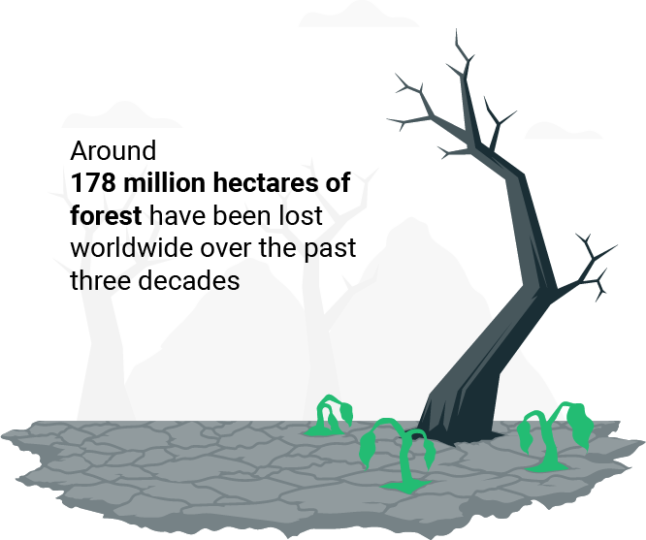Climate Change: Statistics, Facts & Proof 2023

Climate change is one of the main issues of our time. Our planet’s climate is changing rapidly, thus threatening nature and humanity. It’s no secret that global temperature has increased as a result of human activity, and if we don’t do something about it soon, we will experience catastrophic warming, rising sea levels, and mass extinction of species.
The following statistics gathered by LawnStarter will give you a better view of the most interesting facts and latest statistics on climate change.
Topics Covered
Climate Change Is Real and
Human-Made
General Climate Change Statistics
Main Causes Behind Climate Change
The Effects of Climate Change

The Impact of Climate Change on Agriculture and Food Supply
Future Effects of Global Climate Change

What Can We Do?
Topics Covered
Climate Change Is Real and
Human-Made
General Climate Change Statistics
Main Causes Behind Climate Change
The Effects of Climate Change

The Impact of Climate Change on Agriculture and Food Supply
Future Effects of Global Climate Change

What Can We Do?
Key Findings
– 99.9% of scientists agree that climate change is real and is mainly caused by humans.
– The Earth’s temperature has risen by 0.14° F per decade since 1880, but the rate of warming has been
more than twice that rate: 0.32° F per decade since the 1980s.
– The Earth experienced its sixth-hottest July and year on record, with a July 2022 land and ocean
surface temperature of 1.57° F above the average for the last century.
– 9 of the 10 warmest years for the contiguous 48 states have occurred since 1998, with 2012 and 2016
being the hottest on record.
– Greenland lost 280 gigatons of ice annually from 2002-2021, causing a global sea level rise
of 0.03 inches per year.
– The average rate of warming has doubled since 1981, and by 2050, 30% of Americans could experience
over 100 days of 90°F temperatures per year.
– 3.3-3.6 billion people are vulnerable to climate change impacts. Without action, it could push
130 million into poverty in the next decade.
Climate Change Is Real and Human-Made
There’s no doubt among scientists about whether climate change is human-made. According to a recent review of 88,125 climate-related studies, over 99% of peer-reviewed scientific papers agree that climate change is mainly caused by humans. This study helps confirm that there’s no remaining scientific doubt about the urgency and gravity of climate change.

General Climate Change Statistics
Global temperature has increased by 0.14° F (0.08° C) per decade since 1880. However, the rate of warming since the early 1980s has been more than twice that: 0.32° F (0.18° C) per decade.
Earth had its sixth-hottest July and year in history as Antarctic sea ice extent dropped to a record low for a second consecutive month. The July 2022 land and ocean surface temperature was 1.57° F (0.87° C) above the last century’s average of 60.4 °F (15.8° C).
Earth’s average land and ocean surface temperature in 2021 was 1.51 °F (0.84 °C) warmer than the twentieth-century average of 57.0 °F (13.9 °C) and 1.87 ˚F (1.04 ˚C) warmer than the pre-industrial period (1880-1900).
The years 2013–2021 rank among the ten warmest years on record. 2021 was also the 45th consecutive year with global temperatures above the 20th-century average.
Since 1901, the median surface temperature across the 48 states has increased at a median rate of 0.17°F per decade. Average temperatures have increased more rapidly since the late 1970s (0.32 to 0.55°F).
Research shows that between the years 2002 and 2021, Greenland lost an average of 280 gigatons of ice each year. This weight loss led the global sea level to rise by 0.03 inches (0.8 millimeters) per year.
Main Causes Behind Climate Change
The primary cause of climate change is global warming. Global warming is a result of the greenhouse effect, a process by which the atmosphere traps some of the Sun’s heat, thus allowing our planet to maintain the necessary conditions for life. Without it, the average temperature of the Earth would be -18ºC.
So, what’s the issue? Well, daily human activity maximizes the greenhouse effect, thus making the planet’s temperature rise even more and disrupting the usual balance of nature.
Greenhouse gases
Carbon dioxide, Methane, Nitrogen oxide, and HCFCs are the main greenhouse gases caused mostly by burning fossil fuels.
Research shows that we can avoid the worst climate impacts by cutting emissions. However, the current path of CO2 emissions could increase the global temperature up to 4.4°C by the end of the century. So, in order to avert the most devastating effects of climate change and keep global warming to no more than 1.5°C—as indicated in the Paris Agreement—emissions must drop by 45% by 2030 and 100% by 2050.


Deforestation
The destruction of land ecosystems and deforestation are some of the leading causes of climate change. Trees store carbon, and when they are cut, they release it, thus causing emissions.
Around 178 million hectares of forest have been lost worldwide over the past three decades. Because forests absorb CO2, this destruction limits nature’s ability to keep emissions out of the planet, thus creating a greenhouse effect and contributing significantly to global warming and climate change.
Destruction of marine ecosystems
The ocean absorbs around 90% of the excess heat trapped in the atmosphere by greenhouse gases and takes in around 25% of CO₂, thus regulating the global climate. However, oceans have a limit, and when they reach it, they acidify, thus destroying marine ecosystems.

Population increase
The human population is growing quickly. Today, there are more than 8 billion people, and this number is expected to increase by at least another 2 billion in the next three decades.
A growing population needs more and more resources such as oil, gas, coal, and other fuels that, when burned, spew enough CO2 into the atmosphere to retain warm air inside like a greenhouse, thus majorly contributing to global warming.

The Effects of Climate Change
Climate change poses many threats to humans and other forms of life on Earth. Its effects are already witnessed: extreme weather, melting of the polar ice and rising sea levels, imperiled ecosystems and extinction of species, and many more. Scientists predict that the situation will worsen if nothing is done.
Health risks
Climate change is one of the biggest health threats facing humanity. It is estimated that every year avoidable environmental factors take the lives of more than 13 million people around the world. This includes climate change which is harming health through air pollution, extreme weather phenomena, poor nutrition, displacement, and more. Thus causing more diseases, increasing fatality, and making it challenging for healthcare systems to keep up.
About 99% of the population breathes unhealthy air resulting from the burning of fossil fuels. Air pollution and climate change are two sides of the same coin, so they should be addressed jointly.
Poverty and displacement
Extreme weather, land degradation, and lack of fresh water are increasing poverty and displacing people. About 3.3 to 3.6 billion people’s daily lives are highly vulnerable to climate change, and without concerted actions, around 130 million people may live in poverty over the next decade, which also triggers displacement.
Over the past decade (2012–2021), around 21.6 million people worldwide were internally displaced each year because of weather-related events.
Most refugees come from countries more vulnerable to climate change and less ready to adapt to its impacts. The countries with the most internally displaced people as a result of disasters are:

1.4 million
Afghanistan

943,000
China

700,000
Philippines

579,000
Ethiopia

527,000
South Sudan
It is predicted that these numbers will continue to rise—1.2 billion people could be displaced globally by 2050 due to climate change and natural disasters.
Most refugees come from countries more vulnerable to climate change and less ready to adapt to its impacts. The countries with the most internally displaced people as a result of disasters are:

1.4 million
Afghanistan

943,000
China

700,000
Philippines

579,000
Ethiopia

527,000
South Sudan
EP predicts that these numbers will continue to rise—1.2 billion people could be displaced globally by 2050 due to climate change and natural disasters.
Extreme weather phenomena
As greenhouse gas concentrations increase so does the global surface temperature. The last ten years, 2013-2021, rank among the ten warmest years on record. Since the 1980s, each decade has been hotter than the previous, and this is expected to continue. Some of the consequences of global warming include wildfires, heat waves, hurricanes, floods, and storms—causing migration, death, and material damage.
Wildfire seasons have lengthened worldwide. It’s estimated that the area of forest burned has doubled in the last decades, and by 2050, the land area burned in Western states is expected to increase by two to six times. Wildfires are also expected to increase in rainier regions (Southeast) by 30%.
The frequency and intensity of hurricanes has also increased since 1980s and will continue to increase as the climate warms. Hurricane wind speeds and the proportion of hurricanes that reach the most intense levels are projected to rise by about 10%.
Melting of the poles and rising sea level
Warmer temperatures cause the melting of polar ice, thus increasing the sea level and threatening to submerge coastal and island communities.
Research shows that between the years 2002 and 2021, Greenland lost an average of 280 gigatons of ice each year. This weight loss led the global sea level to increase by 0.03 inches (0.8 millimeters) per year.

Similarly, between 2002 and 2020, Antarctica lost an average of 150 gigatons of ice per year, causing the global sea level to increase by 0.4 millimeters per year.
Imperiled ecosystems and extinction of species
Climate change is increasing pressure on wildlife to adapt to new conditions fast. And while ecosystems have the capacity to adapt, many are near the limit of their natural adaptation capacity, and some are already reaching or surpassing their limits.

Around 1 million animal and plant species are in danger of extinction, many of them within decades. The rapid loss of species worldwide is projected to be between 1,000 and 10,000 times higher than the rate at which extinction would naturally occur. But the good news is this can be prevented. Prioritizing nature conservation and embracing strategies against climate change can enhance species’ survival.
The Impact of Climate Change on Agriculture and Food Supply
One of the main causes of the global hunger crisis is climate change. The combined effects of warmer temperatures and weather extremes can have disastrous impacts on crops. A 6% decrease in global wheat yields and a 10% decrease in rice yields is projected for each additional 1°C increase in global temperature, with substantial impacts on undernutrition and stunting in poorer regions.
Future Effects of Global Climate Change
Our planet will continue to warm, and the effects will be devastating. The last seven years were the hottest on record. There’s a 48% chance that during at least one year in the next five years, the yearly average temperature will be 1.5°C higher than the 1850-1900 median. Worldwide, by the 2050s, more than 1.6 billion people living in over 970 cities will be continuously exposed to 3-month median temperatures reaching above 35 °C (95 °F).
The potential future effects of climate change include more wildfires, longer periods of drought, and a rise in the intensity and duration of tropical storms.
What Can We Do?
The severity of the effects caused by climate change will depend on human action. More greenhouse gas emissions will lead to increased global warming and widespread environmental damage. So, if we can decrease emissions, we can avoid some of the worst effects.
To combat climate change, we must be climate-resilient, sustainable, and low-carbon. Additionally, we can advocate for mitigation policies that decrease gas emissions. This will also result in multiple benefits by simultaneously dealing with climate change and air pollution, which takes the lives of 7 million people each year.
Solutions to climate change exist, but we must act, and fast!